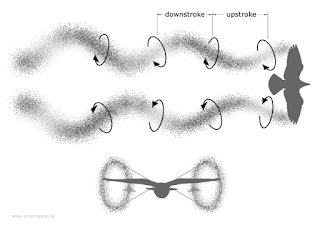In my presentation of the wild duck, I brought a picture taken by Eadweard Muybridge of a bird in flight. From the picture, I jumped to a schematic of the upward and downward stroke. I found a better diagram that illustrates the flight, from a front view to a top view.
Muybridge came to mind because before this class I never truly considered how hard it is to study the movement of animals. Without the ability to expand and contract the time scale of their movements, they can be all but invisible. The problem of bird flight fascinated minds as brilliant and Leonardo Da Vinci. But without photography, it proved simply too challenging to link the shape of the wings, which was known, to the movement that created flight. The motion of the bird wing is one crucial piece of the problem of bird flight. What also surprises scientists is the efficiency of bird flight. There are some migratory species that fly for weeks spending very little energy in their path. The problem boils down to figuring out how a bird wing and body reduce drag during flight.
The picture above belongs to a starling flying in a wind tunnel. The starling is faced with an air flow that also contains traces of smoke. This is the same method airplane companies use to study the efficiency of their wings. The traces above are the currents of air traveling above and below the bird.
A large part of the drag depends on the point where the vortices begin. Notice how the air flow is regular up until the middle of the body, only to expand in the second half. From this still image, we can derive measurements of the pressure along the body of the starling, as well as the wind velocity.
What the picture shows to use, which would be invisible otherwise, is how the starling pushes the
air around and how the air in turn, creates the lift and drag on the wings. It surprises me again how a
simple photograph combined with a few traces of smoke can help us break down a problem that is
extremely difficult, into simpler parts, just as it was the case with the
wing beat.
Danny W Chang


this is brilliant in the way you show what can be learned from that starling photograph in the wind tunnel, it's as if making the visible invisible. excellent explanation too!
ReplyDelete